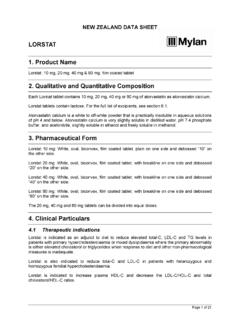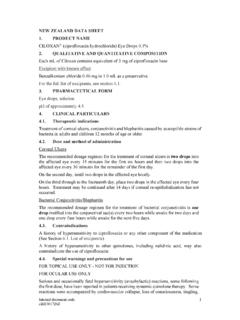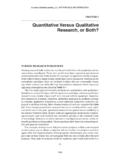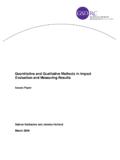Transcription of The Strengths and Weaknesses of Research …
1 IOSR Journal Of Humanities And Social Science (IOSR-JHSS). Volume 19, Issue 4, Ver. III (Apr. 2014), PP 99-104. e-ISSN: 2279-0837, p-ISSN: 2279-0845. The Strengths and Weaknesses of Research Methodology: Comparison and Complimentary between Qualitative and Quantitative Approaches Looi Theam Choy (Faculty of Arts and Social Science, University of Malaya, Malaysia). Abstract: The purpose of this study is compared Strengths and Weaknesses of qualitative and quantitative Research methodologies in social science fields. Reviewed recent secondary resources, there is no best approach between both Research methodologies due to existing Strengths and Weaknesses among both types of Research methodologies. To plan and implement a Research , choosing either one Research methodology will still be occurred Strengths and Weaknesses for the Research .
2 This common study only based on existing secondary data and sources to interpret results. No primary data approach on this study due to sufficient source and data from secondary resources. The defined cases have proven that complementary approach between qualitative and quantitative approaches for a same Research topic may provide expected results as both references better than just thoroughly considering either one Research methodology approach. Keywords: Qualitative Approach, Quantitative Approach, Qualitative Research Methodology, Quantitative Research Methodology. I. Introduction Introduction of Quantitative Approach in Research Methodologies The process of conducting a quantitative study begins with a researcher selecting a topic. Quantitative researchers typically start with a general area of study or issue of professional or personal interest.
3 Researchers must narrow it down to, or focus on, a specific Research question that can be addressed in the study. Often this requires a careful review of the Research literatures and developing hypotheses that frequently come from social theory (Neuman, 2006: 14). Designing the study requires making decisions about the type of case or samples to select how to measure relevant factors and what Research techniques such as questionnaires or experiments to be employed (Neuman, 2006: 14). In addition, quantitative methods characteristically refer to standardized questionnaires that are administered to individuals or households, which are identified through various forms of sampling usually random sampling (Dudwick, Kuehnast, Jones and Woolcock, 2006: 3). Basically, probability or non-probability sampling approaches are required researchers to choose a proper way before drawing a sample size.
4 Next is the data collection step. A quantitative researcher will very carefully record and verify information, almost always in one form of numbers and usually transfer the data into computer-readable format (Neuman, 2006: 14). Quantitative data can help establish correlations between given variables and outcomes. Such data should allow others to validate original findings by independently replicating the analysis (Dudwick, Kuehnast, Jones and Woolcock, 2006: 3). After that, analyze data step will be replaced. Often the Research ends up with a large quantity of computer-generated output that provides the researcher next has to give meaning to or interpret the data. To draw a theory, quantitative researchers have to look at the analyzed data, using background knowledge on the Research topic and questions.
5 A researcher also considers alternative interpretation of the data compares the results of the study with previous studies and draws out its wider implications. The final step is to inform others means writing a report in a specific format for the study (Neuman, 2006: 14). Introduction of Qualitative Approach in Research Methodologies Qualitative researchers begin with a self-assessment and reflections about themselves as situated in a social-historical context. It is a highly self-aware acknowledgement of social self, or of a researcher s position in society. This type of approach does not narrowly focus on a specific question but ponder the theoretical philosophical paradigm in an inquisitive, open-ended settling in proves as they adopt a perspective (Neuman, 2006: 15).
6 And also, qualitative methods typically refer to a range of data collection and analysis techniques that use purposive sampling and semi-structured, open-ended interviews (Dudwick, Kuehnast, Jones and Woolcock, 2006: 3). 99 | Page The Strengths and Weaknesses of Research Methodology: Comparison and Complimentary between A qualitative researcher also will design a study, collect data, analyze data and interpret data same like a quantitative researcher does. He or she also tends to build new theory as well as draw on existing theory during these steps. At the interpret data stage, he or she creates new concepts and emphasize constructing theoretical interpretations (Neuman, 2006: 15). At last, the final step called informs others but the report styles to present results to other people vary by approach (Neuman, 2006: 15).
7 Background to the Study Problems Qualitative researchers often rely on interpretive or critical social science. They apply logic in practice and follow a nonlinear Research path. They emphasize conducting detailed examinations of cases that arise in the natural flow of social life. In contrast, most of the quantitative researchers rely on a positivists approach to social science. They apply reconstructed logic , and follow a linear Research path. Quantitative researchers emphasize precisely measuring variables and testing hypotheses that are linked to general causal explanation (Nueman, 2006: 151). One of the differences between the two styles comes from the nature of the data. Soft data, in the form of impressions, words, sentences, photos, symbols and so forth, dictate different Research strategies and data collection techniques than hard data, in the form of numbers.
8 Other differences are different assumptions about social life and different objectives. The differences can make tools used by the other style inappropriate or irrelevant. People who judge qualitative Research by standards of quantitative Research are often disappointed, and vice-versa (Neuman, 2006: 151). Researchers who use one style alone do not always communicate well with those using the other, but the languages and orientations of the styles are mutually intelligible. It takes time and effort to understand both styles and to see how they can be complementary (Neuman, 2006: 151). The historically negative bias against qualitative Research is discussed, as well as the Strengths and Weaknesses of both approaches, with issues highlighted by reference to nursing Research .
9 Consideration is given to issues of sampling, the relationship between the researcher and subject, methodologies and collated data, validity, reliability, and ethical dilemmas (Carr, 1994: 716). For other potential biases in data collection procedures, there may be no clear advantage to either qualitative or quantitative approaches, although qualitative Research methods have the advantage that they may be able to identify and handle response bias as it occurs, rather than afterwards. For example, biases due to the respondent s mental set refer to the way that perceptions based on previous items influence replies to later ones. In the social desirability bias, a respondent replies so as to appear socially acceptable in eyes of interviewer. Acquiescence bias, similarly, covers responses that are influenced by the respondent s perception of what would be desirable to the researcher, especially to an influential one (Mcdowell and Maclean, 1998: 19).
10 Objectives of the Study This study is purposely and merely compared the Strengths and Weaknesses of quantitative and qualitative Research methodologies in social science fields. Evaluation among the Strengths and Weaknesses of quantitative and qualitative Research methodologies also the objective for this study in the field of social science. Identification of complementary between both qualitative and quantitative approaches also the intention for this study. Significance of the Study To identify the Strengths and Weaknesses of both qualitative and quantitative Research methodologies are appropriated paths for researchers selecting their Research methodologies according to their specific topics. Thus, researchers can decide their Research methodologies referring to this evaluation.

















